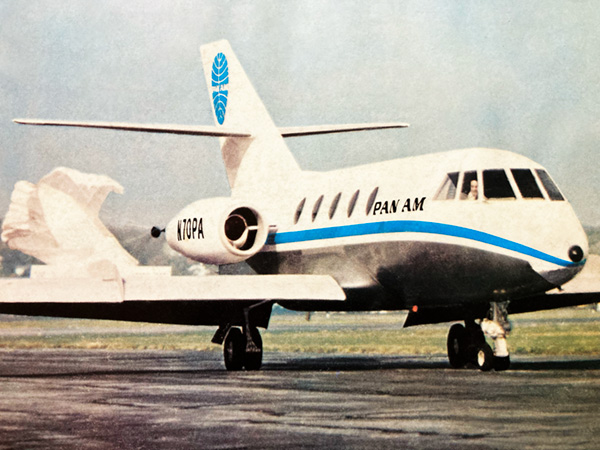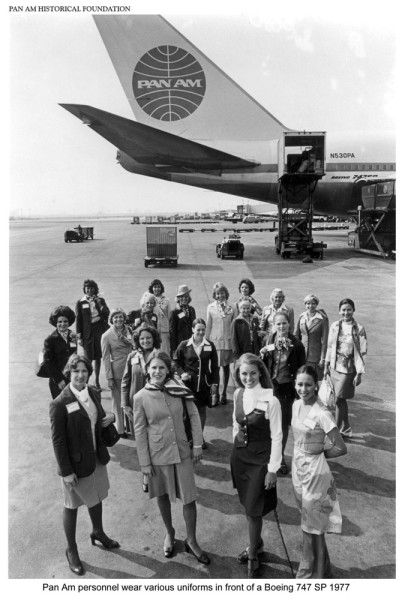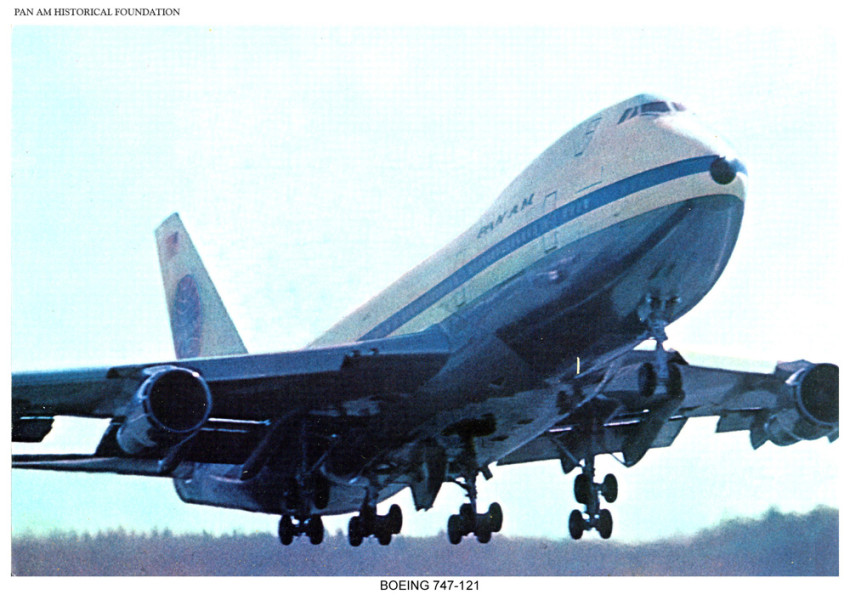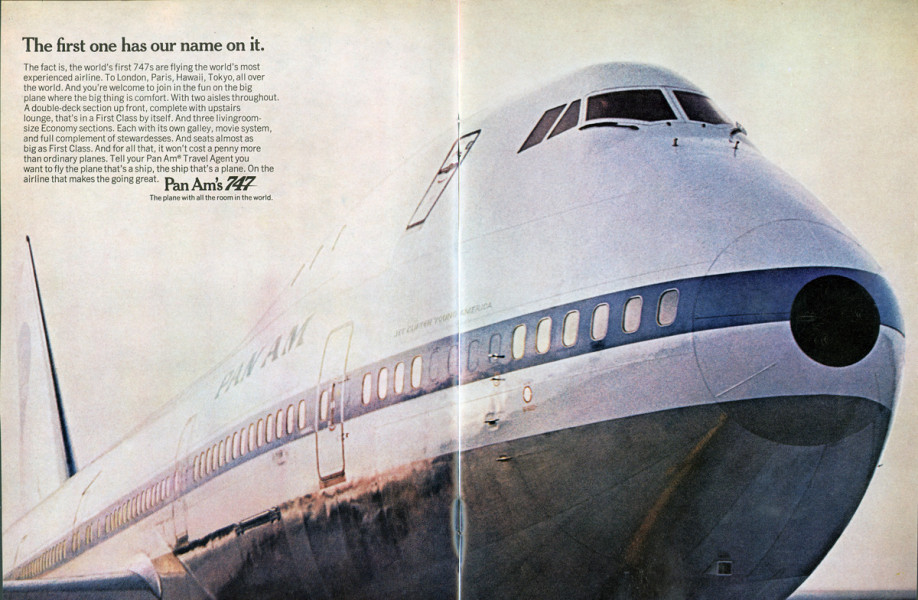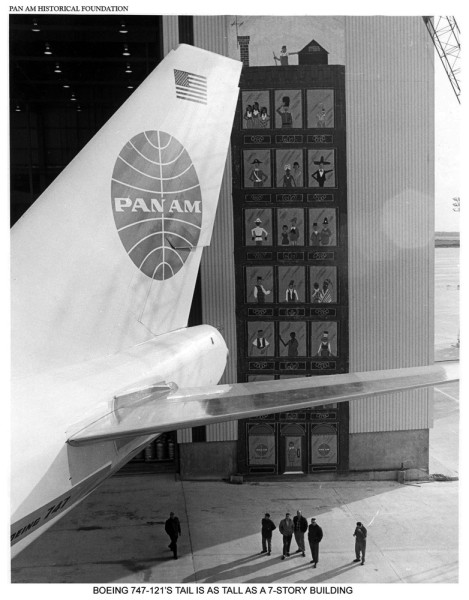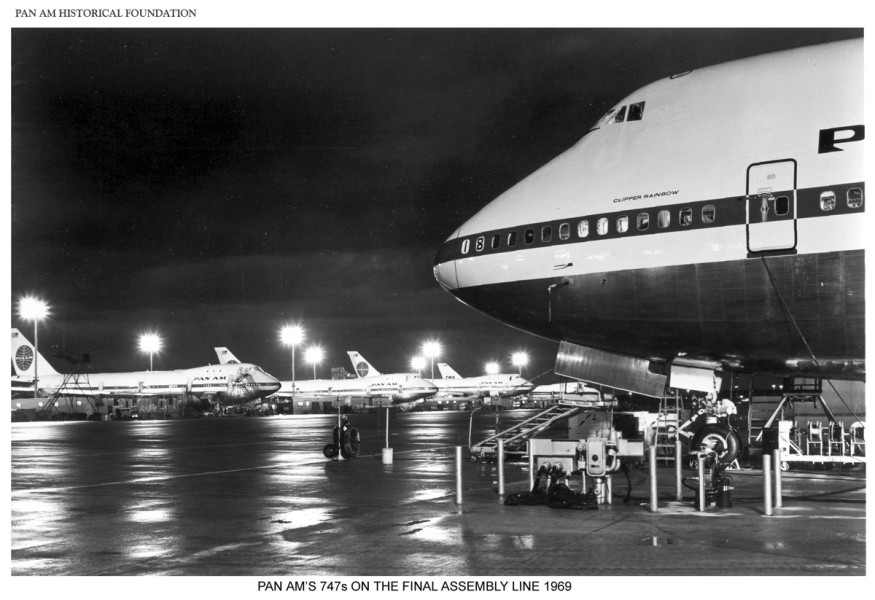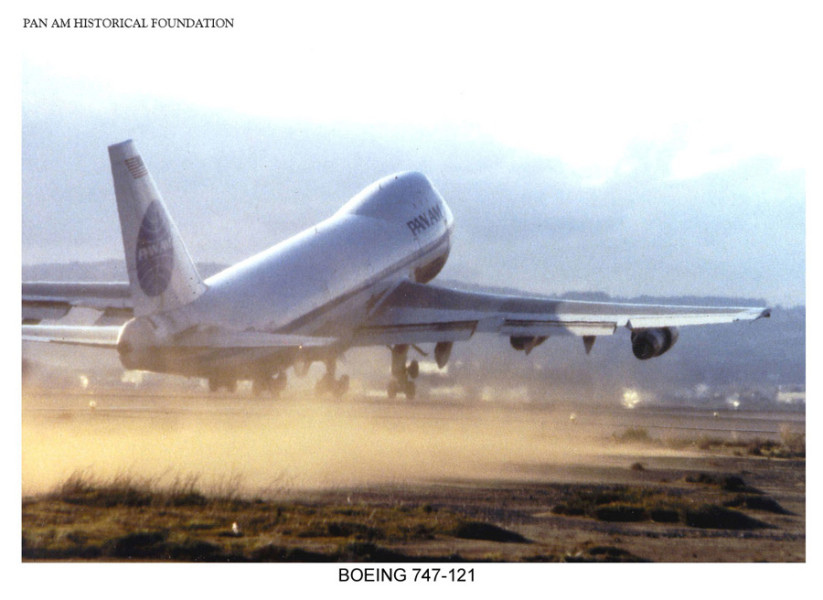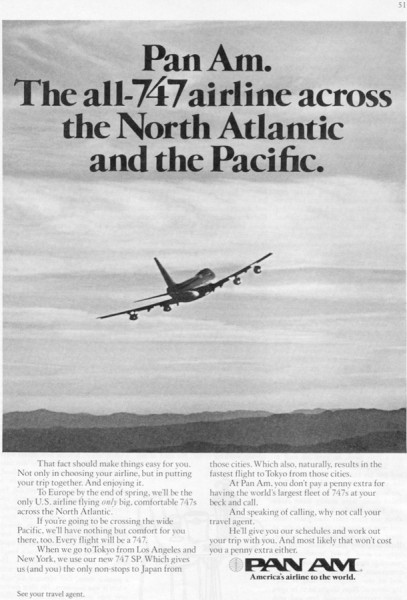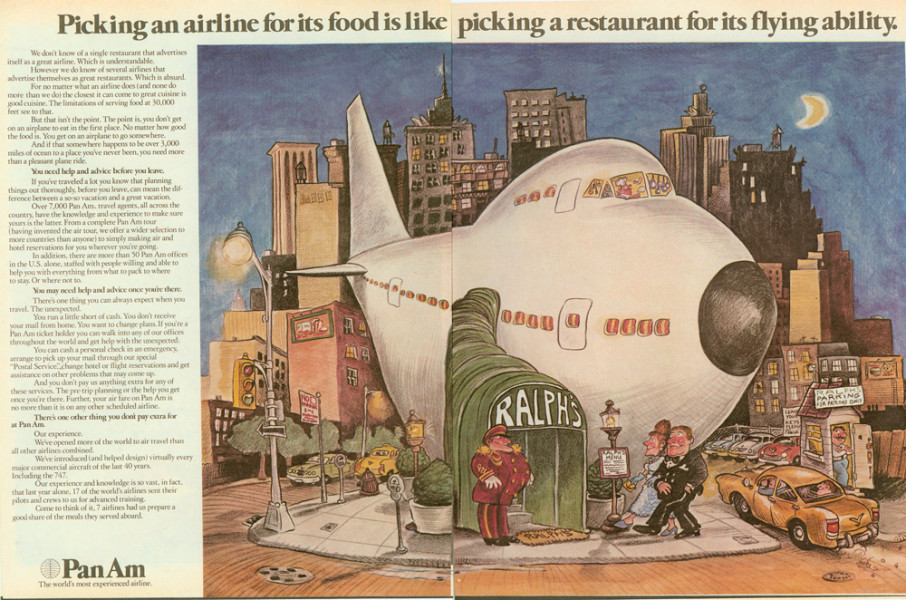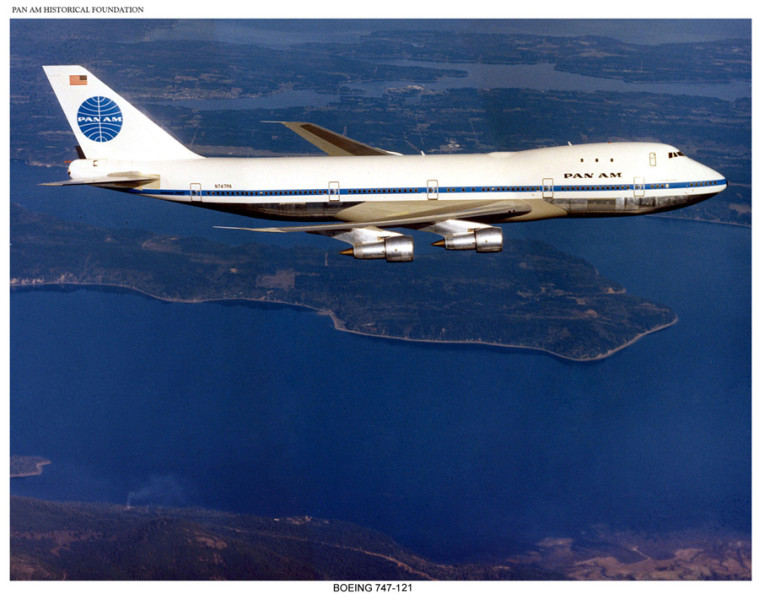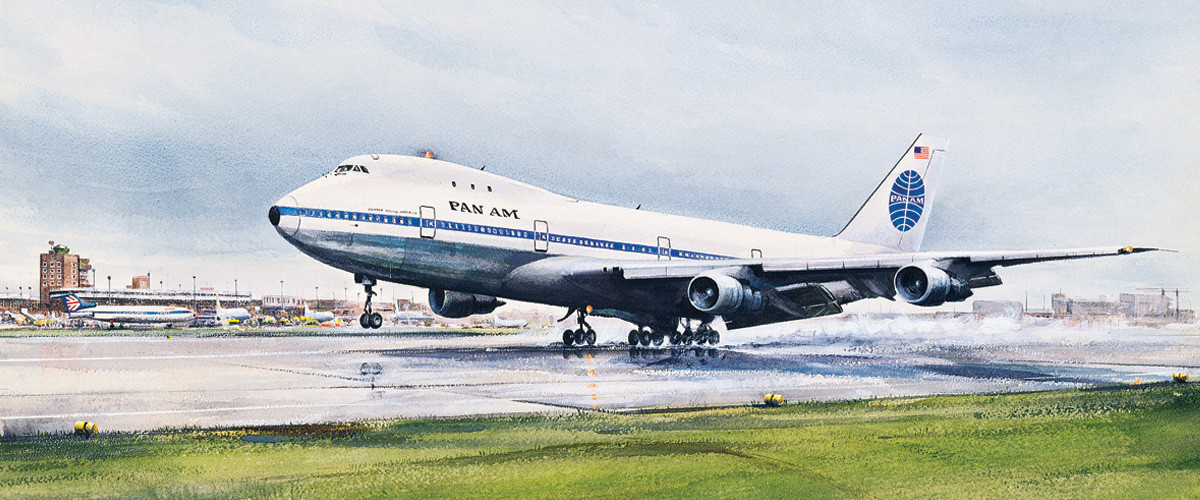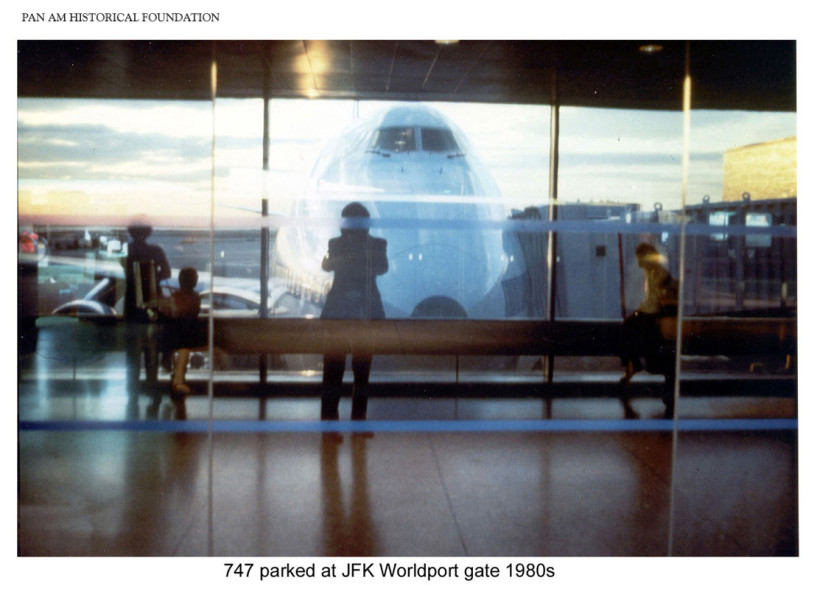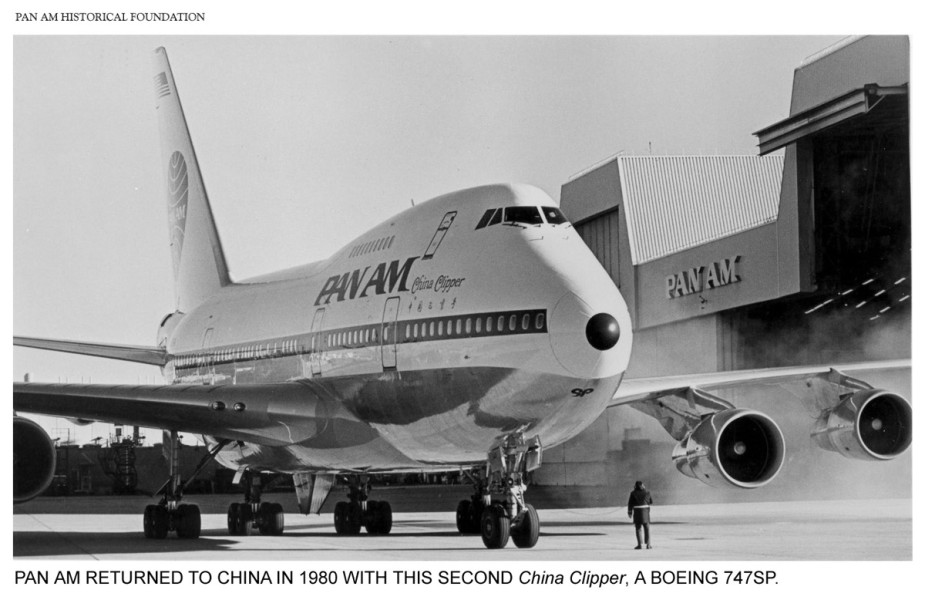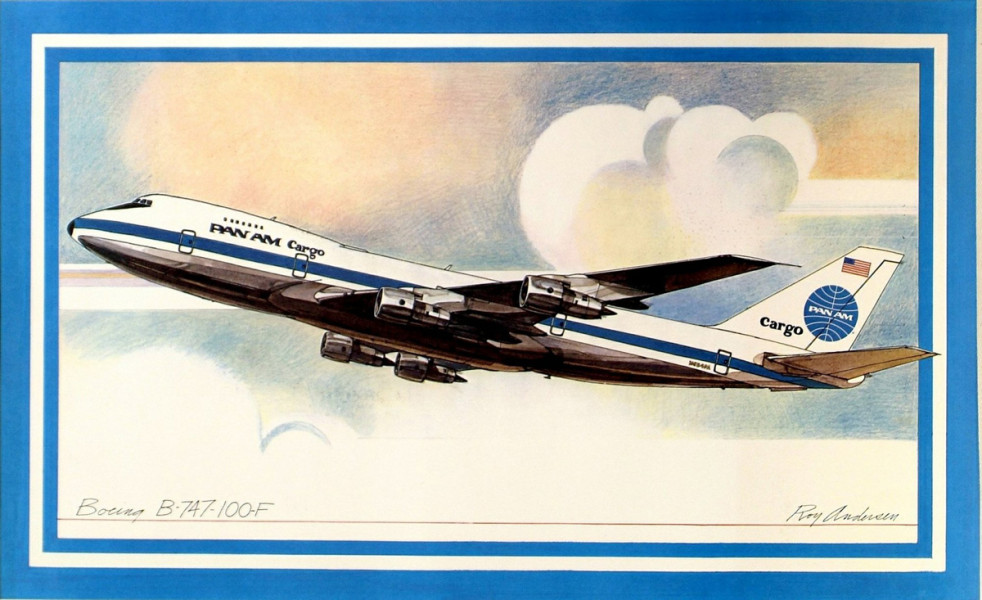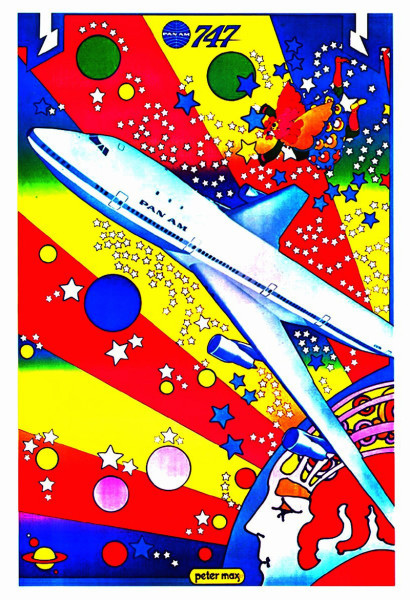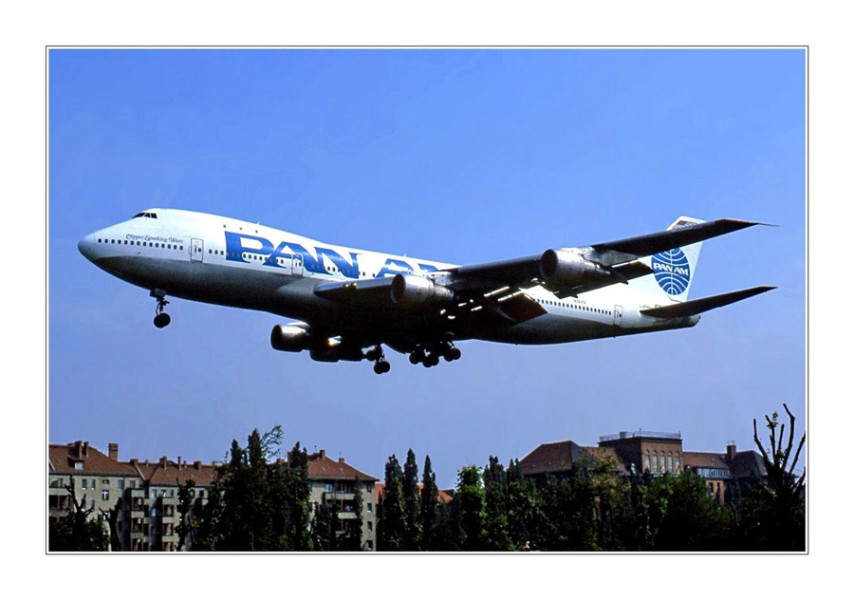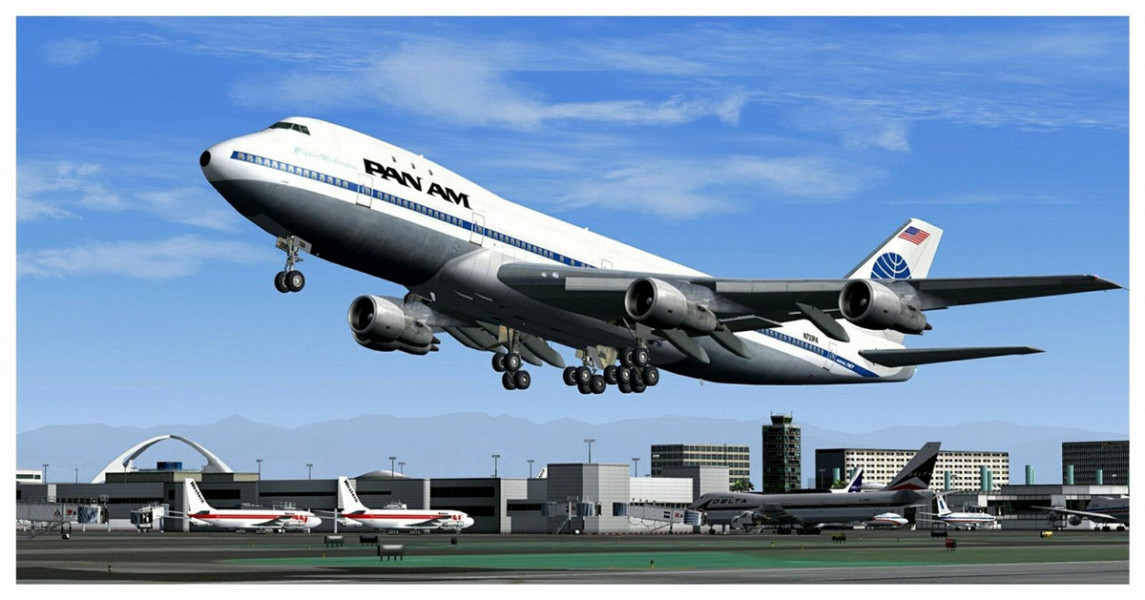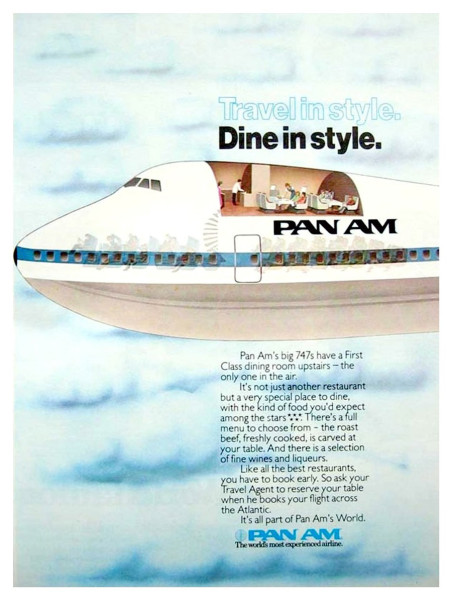PART 2
PAN AM AIRCRAFT - 1962 & BEYOND
Juan Trippe's forward thinking led to
"Air Travel for All," the Boeing 747, and global jet travel
Comparison of Pan Am's new Boeing 747 Jet Clipper in 1970, and PAA Ford Trimotor Clipper that flew in 1929.
From Juan Trippe's personal collection, courtesy of Ed Trippe.
1962 - Pan Am 707-321
Improvements in performance continued. In 1962 the new, yet more powerful fan-jet engine produced the 321-B model, which stretched the 707's range to 4,600 miles, reduced fuel burn, further increased its payload and cut a half mile off its takeoff distance. Pan Am 321-Bs could fly from New York nonstop beyond Rio to Buenos Aires and nonstop between California and London. Flights between San Francisco and Tokyo no longer had to fly 1,400 miles out of their way to Honolulu for fuel; they now flew nonstop.
The 321-B and its counterpart the 321-C, became the backbone of the Pan Am fleet. Over the years, Pan Am bought 130 707s of various models.
"AIR TRAVEL FOR ALL"
JUAN TRIPPE'S DREAM OF A MASS MARKET OF WORLD TRAVEL
Far from being a luxury for the affluent, the jets opened up a mass market of world travel. Jet power could lift payloads that propeller designers could but dream of. Their speed enabled them to make nearly twice as many flights as props. In the jet engine, unlike piston engines, all the parts spun in the same direction. So it eliminated vibration, failed less frequently and went longer between overhauls. Flying mostly above the weather, jets reached a new height in terms of both altitude and passenger comfort.
Economy Fares
Jets weren't all Pan Am introduced in 1958. It also introduced economy fares, lower still than the tourist fares it had previously introduced. From the beginning, Trippe's vision was mass air transport. In 1943 he announced a goal of flying 150 passengers from New York to London in 10 hours at a one-way fare of $100. After 15 years he had achieved the capacity and speed goals and he continued progressing toward the cost target. The result was clear: in the '60s, traffic boomed.

By 1961, between jet productivity and economy fares, Pan Am reached new highs not only in traffic, but in revenue and profit, earning $26 million on $460 million in revenues. It also reversed the creeping rise in operating costs, from 53.9 cents to 49.1 cents a ton-mile. In 1963, operating profit soared to $79 million on $561 million in revenue. The next year, substantial fare reductions were introduced.
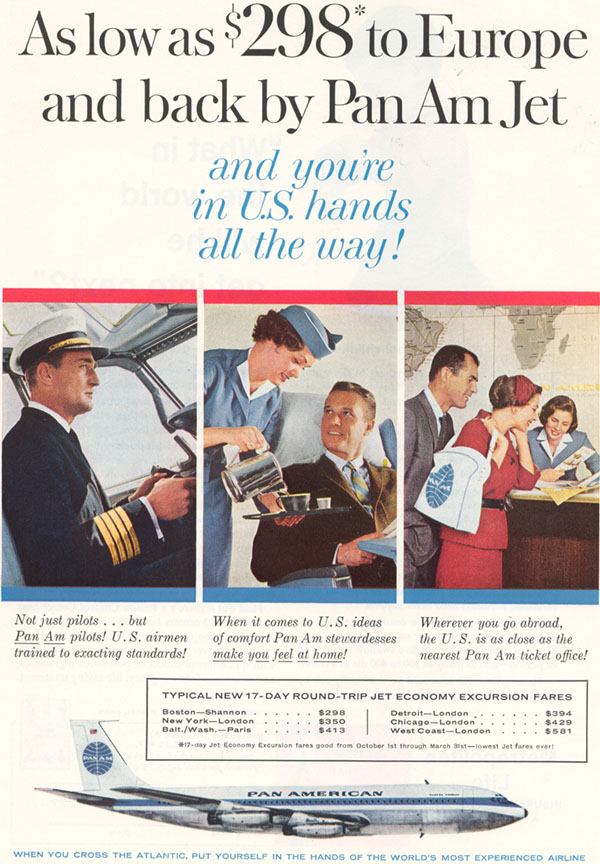
1963 - Vertol Helicopters and the Pan Am Building Heliport
In 1963 Pan Am also built an airport - or more properly, a heliport - 808 feet high, in the middle of Manhattan, atop its brand-new skyscraper, the Pan Am Building. The following year with substantial Pan Am cooperation, New York Airways began offering helicopter service, using Vertol twin-jet helicopters, between mid-Manhattan JFK and Newark Airports with stops at Wall Street. Later, in 1965, Pan Am opened its heliport with flights to airports on New York Airways.
1963 - Pan Am Boeing 720-B
As jets replaced props on the longer routes, Pan Am turned to the shorter ones. Boeing had shortened the 707 fuselage and wings to carry fewer passengers over shorter routes for a domestic airline. Pan Am bought nine of these 720-Bs for its Caribbean and Central American routes in 1963. Pan Am didn't fly the 720-B for very long, however, because Boeing was now producing three-engine Boeing 727s for shorter hauls with fewer passengers.

Photo: Pan Am Boeing 720-030B at Miami International, taken in 1971 by Jon Proctor
(Wikimedia: https://commons.wikimedia.org/wiki/File:Boeing_720-030B,_Pan_Am_JP7163374.jpg)
1963 - All-Cargo Jet Service with the Pan Am 707-321-C

Photo: A Pan Am -321 model, the cargo version, shown loading at JFK Airport in New York City.
In the same year Pan Am introduced the first all-cargo jet service. The 707-321-C had a cargo door, palletized loading, and carried more than 38 tons of cargo over the oceans. Pan Am had long dominated the air cargo market, and in 1963, now with cargo jets, it sold over 200 million cargo ton-miles, virtually double its 1958 volume. Its engines were a third more powerful than the -121s, and its longer range made it the first truly nonstop intercontinental jet.
1965 - Business Jets: Pan Am Dassault Falcon 20
Photo: Pan Am Dassault Falcon fan jet, using a drogue chute to decelerate on landing
In 1965, Pan Am became the American distributor of the Fan Jet Falcon, a pioneer jet-powered aircraft. Dassault Aviation in France built the sleek business jet, and General Electric in America provided the engines. The Falcon 20 shown used a drogue chute to decelerate on landing. Later Dassault models used thrust reversers.
1965 - Pan Am Boeing 727

Germany
Pan Am ordered 25 Boeing 727s in 1965, and the next year 727s replaced the DC-6Bs that were flying 650 flights a week between cities in West Germany to the isolated city of West Berlin. The trijet's short takeoff and landing run was ideal for Templehof's fixed-length. The 727 jet cut flying time from Berlin to the free world. The flight took just 35 minutes and carried more passengers with fewer aircraft.
Vietnam
In another humanitarian mission, 727s flew the famed Vietnam R&R airlift, which carried tens of thousands of American servicemen for R&R leaves in Hong Kong, Tokyo and other Asian points during that prolonged war. 727s departing Saigon took off at maximum climb angle to get out of range of small arms fire as quickly as possible. Still, bullet holes were found in more than one.
Latin America
Pan Am's 727s also took over the short haul routes in the Caribbean, Bahamas and Latin America, and finally retired the last of the piston aircraft from the Pan Am inventory. When Pan Am purchased National Air Lines in 1980, National's 727 fleet joined Pan Am's. At its high point, the combined fleet numbered 97.
WITH AIR TRAVEL BOOMING IN THE FIRST JET DECADE, AND PROMISING CONTINUED GROWTH, MORE CAPACITY WOULD CLEARLY BE NEEDED. AIRPORT CONGESTION WAS APPROACHING SATURATION, WHICH FORECLOSED SIMPLY BUILDING MORE AIRPLANES. THE ANSWER WAS BIGGER ONES.
1969 - JUAN TRIPPE & PAN AM'S BOEING 747 TRANSPORT
When Pan Am thought about bigger airplanes, it thought not in terms of modest growth, but in terms of doubling. Boeing had just lost the competition to build a larger-than-ever military transport, but, driven by Trippe's persistent demands for a quantum leap in aircraft size, the Seattle manufacturer re-invigorated and radically revised its design efforts. The result was an airplane that surpassed the ambition and imagination that led to the first jets: the 747. Juan Trippe ordered 25 of them in April 1966.

Pan Am B747 & Pan Am's Juan Trippe with Boeing's Bill Allen

Boeing 747 in production, Everett Washington
The 747 left the earth weighing 355 tons, could carry 490 passengers, cruise at 565 miles an hour for 4,800 miles. Its new turbofan engines delivered an amazing 47,500 pounds of thrust, more than triple the power of the first 707s. Yet it was quieter and required 1,800 feet less runway than earlier jets.
Juan Trippe retired from Pan Am just months before the first Boeing 747 took its first test flight. But the Pan Am Boeing 747 wide-body jet recreated the same public sensation and excitement that the first jets had a decade before.
1976 - The 747SP

Photo: 747 SP Record Setter: Clipper New Horizons at San Francisco, preparing for Pan Am's 50th Anniversary Flight around the Poles
While the 747 dominated the skies around the world, Pan Am ordered another permutation: one that could fly, nonstop, with a full load, the 6,754 miles between New York and Tokyo, the world's two largest metropolitan areas. Boeing shortened the 747's fuselage by 46 feet, reducing capacity to 233 passengers, and increased its fuel capacity. It reduced its weight by 17 tons. The modifications yielded a 7,000-mile range, and the 747SP - for Special Performance - made the nonstop flight in 13 hours.
PAN AM JETS IN THE 1980s
In subsequent years, Pan Am bought other jet transports. With its purchase of National Air Lines, it acquired 16 McDonnell-Douglas DC-10s and ordered 12 new Lockheed L-1011 trijets, which filled a niche between the capabilities of the 707 and the 747. Another addition to the fleet for shorter range operations was the Boeing 737-200. Eventually Pan Am bought a few of the highly-economical Airbus models, the A-300 and the highly-automated A-310.
1980 - Pan Am DC-10

With its 1980 purchase of National Airlines, Pan Am acquired Douglas jets (by then, the company was renamed McDonnell-Douglas) adding 16 three-engine DC-10s to the Pan Am fleet.
1980 - Lockheed L-1011-500

This sleek Lockheed L-1011-500 also added to Pan Am's wide-body three-engine fleet. In this striking photo, a Pan Am L-1011 departs the Worldport while another awaits its passengers at JFK International.
1982 - Boeing B-737-200
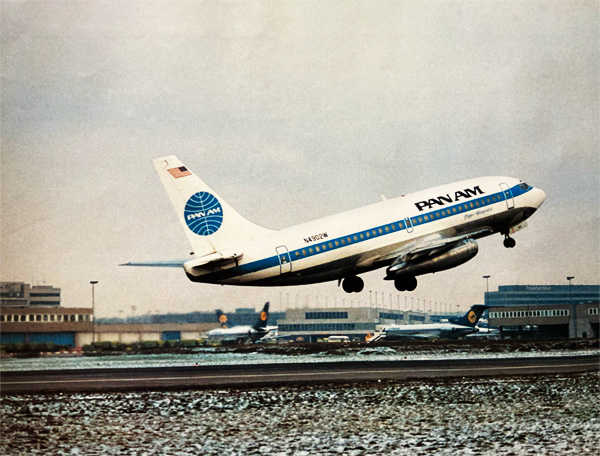
Pan Am's B-737-200, with two engines, was only slightly smaller than its three-engine 727, as jets became more efficient and versatile. The photo shows a Pan Am 737 taking off at Frankfurt, Germany with the terminal in the background.
1984 - Pan Am Airbus A-300 B4
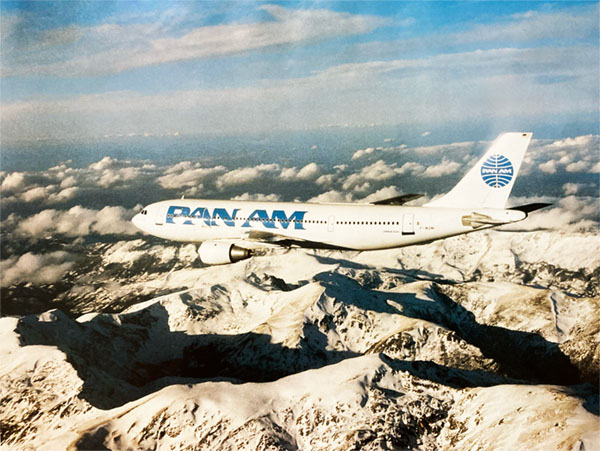
Pan Am went abroad to buy more economical, new technology aircraft from the European consortium Airbus Industrie in 1984. 'sa photo of a Pan Am Airbus A-300 B4 as it flies over the Alps.
1985 - Pan Am Airbus A-310
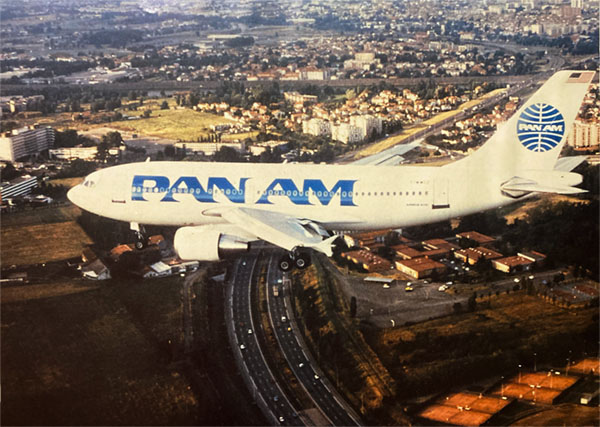
As confidence and performance increased, two engine-jets began flying long over-ocean routes. The Airbus A-310, with the most automated systems to date, was capable of intercontinental nonstop flights.
BUT FOR BOLD INNOVATION, NONE RIVAL PAN AM'S ORDERS CREATING THE 707 OR THE 747 AND THRUSTING WORLD AVIATION INTO THE JET AGE.
-- Article adapted from the Pan Am Historical Foundation annual calendar, 1998
Related Articles:



